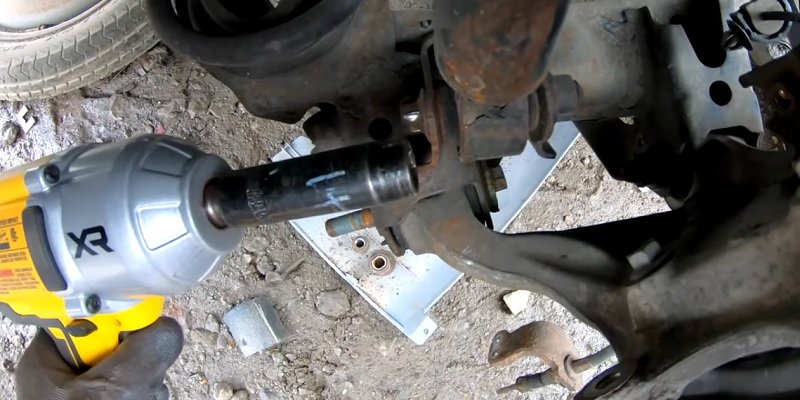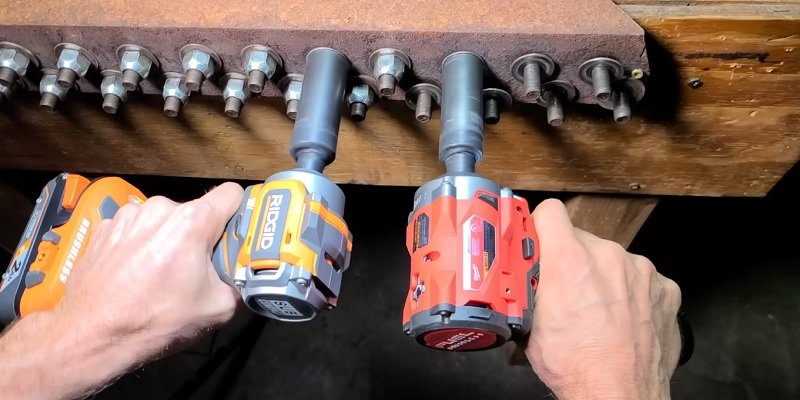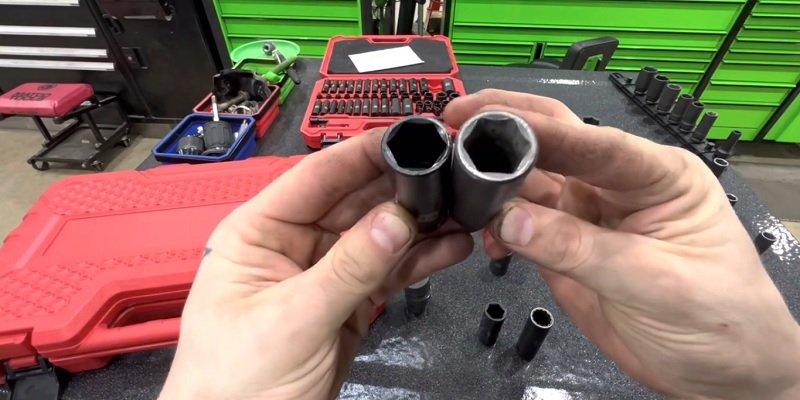Disclosure: This post contains affiliate links and I will be compensated if you make a purchase after clicking through my links. Learn More
To put a socket on an impact wrench, simply align the socket with the exposed drive shaft and push it on until it securely clicks into place. Using an impact wrench can make tasks like removing lug nuts or tightening bolts much easier and more efficient.
So, in this guide, we will walk you through the steps to put a socket on an impact wrench and provide some useful tips to ensure a proper fit and safety. By following these instructions, you’ll be ready to tackle a variety of projects with your impact wrench and achieve professional-grade results.

Read on to learn more!
Understanding The Socket Attachment Process
The Importance of Proper Socket Attachment
When it comes to using an impact wrench, understanding the socket attachment process is crucial for smooth and efficient operation. Properly attaching the socket ensures a secure connection between the impact wrench and the fastener, allowing for optimal torque delivery and minimal risk of slippage or damage. In this section, we will delve into the importance of proper socket attachment and the key factors to consider.
Components of an Impact Wrench: Key Points to Note
Before we delve into the socket attachment process, let’s take a moment to understand the key components of an impact wrench. This knowledge will help you grasp the relevance of proper socket attachment and its impact on the performance of the tool.
| Component | Description |
|---|---|
| Motor | The power source that drives the rotational force of the impact wrench. |
| Anvil | The square drive mechanism that connects the socket to the impact wrench. |
| Trigger | The control lever that allows you to start or stop the impact wrench. |
| Handle | The grip area of the impact wrench designed for comfortable handling. |
Understanding these components will help you comprehend the significance of proper socket attachment in maximizing the capabilities of your impact wrench.
Socket Compatibility: Choosing the Right Socket for Your Impact Wrench
Choosing the correct socket for your impact wrench is crucial to ensure a secure and seamless connection. Using an incompatible socket can result in poor engagement, socket slippage, and potential damage to both the socket and the fastener. To avoid these issues, consider the following key points:
Socket Size: Ensure that the socket size matches the square drive of your impact wrench. Most impact wrenches have a 1/2-inch square drive, but smaller and larger sizes are available.
Socket Material: Select a socket made from high-quality materials, such as chrome vanadium or impact-grade steel, to withstand the high torque produced by an impact wrench.
Socket Type: Consider the specific application requirements and choose a socket type accordingly, such as deep sockets for accessing recessed fasteners or impact universal sockets for versatile use.
Socket Brand: Opt for reliable and reputable socket brands known for their durability and precision.
By adhering to these points, you can ensure the right socket compatibility, guaranteeing a secure and efficient attachment process for your impact wrench.
Step-By-Step Guide To Attaching A Socket
When it comes to using an impact wrench, attaching a socket is a crucial step that ensures you have the right tool for the job. Whether you’re a seasoned professional or a DIY enthusiast, this step-by-step guide will walk you through the process of attaching a socket to your impact wrench with ease and precision.
Preparing Your Impact Wrench: Essential Checks and Safety Precautions
Before you start attaching a socket to your impact wrench, it’s important to take a few essential checks and safety precautions. These steps ensure that your impact wrench is in good working condition and minimize the risk of accidents. Follow these guidelines to ensure a safe and efficient operation:
- Check the power source: Make sure your impact wrench is unplugged or the battery is disconnected before starting.
- Inspect the impact wrench: Verify that your impact wrench is clean, free from any damage, and all parts are intact.
- Tighten the chuck: Use an adjustable wrench to secure the chuck onto the anvil, ensuring it’s firmly in place.
- Wear protective gear: Put on safety glasses, gloves, and ear protection to safeguard yourself from flying debris and loud noise.
- Prepare a clean workspace: Clear any clutter and ensure you have sufficient space to maneuver your impact wrench.
Choosing the Correct Socket Size: Tips and Tricks
Now that you’ve prepared your impact wrench, it’s time to choose the correct socket size for your specific task. Follow these tips and tricks to ensure you select the right socket:
- Refer to the user manual: Check the user manual of your impact wrench for the recommended socket size for different applications.
- Measure the fastener: If you don’t have the user manual, use a caliper or a tape measure to determine the diameter of the fastener you’re working with.
- Choose the corresponding socket size: Match the measured diameter of the fastener with the appropriate socket size, ensuring a snug fit.
Attaching the Socket to the Impact Wrench: Best Practices
Now that you have the correct socket size, it’s time to attach it to your impact wrench. Follow these best practices for a secure and efficient attachment:
Ensure the impact wrench is turned off: Before attaching the socket, make sure the impact wrench is switched off to prevent any accidental starts.
Align the square drive of the socket with the square drive anvil of the impact wrench.
Insert the socket onto the anvil: Push the socket onto the anvil until it is fully seated and secure.
Ensure a tight fit: Give the socket a gentle tug to check if it’s properly attached. If there’s any movement, remove and reattach the socket to achieve a snug fit.
Positioning the Socket on the Anvil: Alignment Tips
| Step | Action |
|---|---|
| 1 | Ensure the impact wrench is turned off. |
| 2 | Hold the impact wrench with one hand and the socket with the other. |
| 3 | Align the square drive of the socket with the square drive anvil of the impact wrench. |
| 4 | Gently push the socket onto the anvil until it is properly aligned and seated. |
| 5 | Double check the alignment by visually inspecting the position of the socket on the anvil. |
Securing the Socket with the Retaining Pin or O-Ring: Foolproof Techniques
Depending on the design of your impact wrench, you may need to secure the socket further using a retaining pin or o-ring. Follow these foolproof techniques to ensure a secure attachment:
- Locate the retaining pin or o-ring groove on the anvil of your impact wrench.
- Insert the retaining pin into the corresponding hole on the anvil or stretch the o-ring over the groove.
- Ensure the retaining pin is fully inserted or the o-ring is securely in place to prevent the socket from detaching during use.
- Properly secure the retaining pin or o-ring according to the manufacturer’s instructions.
Verifying the Socket Attachment: A Safety Checkpoint
Before putting your impact wrench into action, it’s crucial to verify the socket attachment to ensure your safety and the success of your task. Follow this safety checkpoint:
- Turn on your impact wrench at low speed and run it for a few seconds.
- Check for any unusual movements or sounds that may indicate a loose socket.
- If the socket remains securely attached and the impact wrench operates smoothly, you’re ready to tackle your project.
By following this step-by-step guide, you can confidently and safely attach a socket to your impact wrench. Remember to always prioritize safety and proper tool usage for a successful outcome.
Troubleshooting Socket Attachment Issues
When it comes to using an impact wrench, proper socket attachment is crucial for efficient and safe operation. However, like any tool, issues can arise with socket attachment that can hinder your work. In this section, we will explore some common problems that you may encounter when putting a socket on an impact wrench and provide practical solutions and insights to troubleshoot these issues.
Socket Slippage: Causes and Solutions
One of the most frustrating problems you may face is socket slippage. This typically occurs when the socket does not securely stay in place on the wrench, leading to inefficient and unreliable operation. Here are some common causes of socket slippage and the corresponding solutions:
Causes:
- Worn-out or damaged socket.
- Insufficient socket-to-wrench grip.
- Loose socket retaining mechanism.
Solutions:
- Replace the worn-out or damaged socket with a new one.
- Ensure a proper grip between the socket and the wrench by cleaning both surfaces and removing any debris or grease.
- Tighten the socket retaining mechanism, such as a detent pin or spring ball, to ensure a secure fit.
Socket Sticking: Insights and Remedies
An opposite problem to socket slippage is socket sticking. This occurs when the socket becomes difficult to remove from the impact wrench, causing frustration and potentially damaging both the socket and the wrench. Here are some valuable insights and remedies for dealing with socket sticking:
Insights:
- High torque levels can cause the socket to become jammed onto the wrench.
- Dirt, debris, or rust can accumulate inside the socket, making it difficult to remove.
- Excessive force applied during socket attachment can lead to socket sticking.
Remedies:
- Avoid using excessive torque levels, as they may cause the socket to become stuck.
- Regularly clean the socket, especially the inside, to prevent the buildup of dirt, debris, or rust.
- Apply a small amount of lubricant to the socket and wrench before attaching the socket, ensuring smooth removal.
Regular Socket Maintenance: Tips for Ensuring Optimal Attachment Performance
Prevention is always better than cure, and the same goes for socket attachment issues. By implementing proper maintenance practices, you can ensure optimal attachment performance. Here are some valuable tips to maintain your sockets:
Tips:
- Regularly inspect your sockets for any signs of wear, damage, or defects, and replace them if necessary.
- Keep your sockets clean by wiping them with a cloth after each use, removing any dirt or debris.
- Store your sockets in a clean and dry environment to prevent rust or corrosion.
- Periodically apply a light coat of lubricant to the sockets to keep them functioning smoothly.
By following these simple tips, you can prolong the lifespan of your sockets and ensure reliable and efficient attachment performance.
Pro Tips For Efficient Socket Attachment
Attaching a socket to an impact wrench may sound straightforward, but there are a few pro tips you should keep in mind to ensure smooth and efficient operation. Mastering these techniques will not only enhance your productivity but also extend the lifespan of your tools. In this section, we will explore some essential techniques for socket attachment, using adapters for added convenience, and considerations for specific applications.
Impact Wrench Techniques for Smooth Socket Attachment
When it comes to attaching a socket to an impact wrench, employing the correct techniques can make a significant difference. Follow these strategies for a seamless socket attachment:
- Ensure the impact wrench is powered off before attempting to attach or detach a socket.
- Align the square drive of the socket with the square drive of the impact wrench.
- Apply firm pressure while pushing the socket onto the drive, ensuring a secure connection.
- For removal, pull the socket straight off the drive without twisting.
By adopting these techniques, you can minimize the risk of slippage, enhance efficiency, and protect both your socket and impact wrench from unnecessary wear and tear.
Using Impact Socket Adapters: Enhancing Versatility and Convenience
To expand the range of sockets that can be used with your impact wrench, consider utilizing impact socket adapters. These adapters allow you to connect sockets of different sizes or types to your impact wrench’s standard drive size. Here’s how to make the most of impact socket adapters:
- Select the appropriate impact socket adapter based on the desired socket size conversion.
- Ensure the adapter is securely attached to both the impact wrench drive and the socket.
- Verify that the connection between the adapter and the socket is tight to prevent any slippage during operation.
- Once the adapter is properly in place, you can proceed to use a wider range of sockets with confidence and ease.
With impact socket adapters, you can maximize the versatility and convenience of your impact wrench, allowing you to tackle a broader range of projects efficiently.
Socket Attachment for Specific Applications: Considerations and Recommendations
While attaching a socket to an impact wrench is generally straightforward, different applications may require specific considerations. To ensure optimal performance in various scenarios, keep the following aspects in mind:
- Torque requirements: Match the torque requirements of the application with the capabilities of your impact wrench to prevent overload or inefficiency.
- Socket material: Choose sockets made from high-quality materials, such as chrome molybdenum steel, for improved durability and longevity.
- Socket size: Select the appropriate socket size based on the fasteners you’ll be working with, ensuring a tight fit and successful operation.
By considering these factors and selecting sockets specifically tailored to your application, you can enhance the effectiveness and safety of your socket attachment process.
Frequently Asked Questions Of How To Put Socket On Impact Wrench?
Are There Special Sockets For Impact Wrench?
Yes, there are special sockets designed specifically for use with impact wrenches. These sockets have a stronger construction to handle the high torque generated by the wrench, reducing the risk of breakage. Make sure to use impact-rated sockets to ensure safety and optimal performance.
What Holds Socket On Impact?
An impact socket is held by the friction created between the socket and the fastener. It is designed to withstand high torque and prevent slipping during use. So, the socket stays securely in place while providing a strong grip on the bolt or nut.
Why Won’t My Sockets Fit My Impact Wrench?
Your sockets may not fit your impact wrench because they are not compatible in size or type. Ensure that you are using the correct size socket for your wrench, as they come in different sizes. Additionally, check if you need impact-rated sockets designed to withstand the high torque produced by an impact wrench.
Final Thoughts
To sum up, putting a socket on an impact wrench is a simple process that can greatly enhance its functionality. By following the steps outlined in this blog post, you can ensure a secure and efficient connection between the two tools.
Remember to choose the right size socket, use proper technique, and consider the material and torque requirements. With these tips, you’ll be able to make the most out of your impact wrench and tackle various tasks with ease. Happy wrenching!


